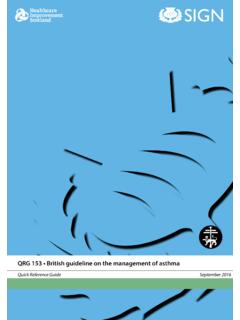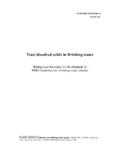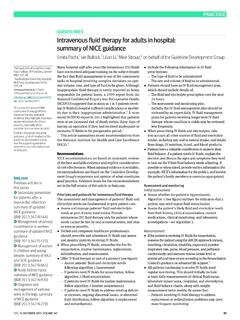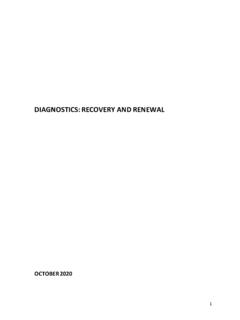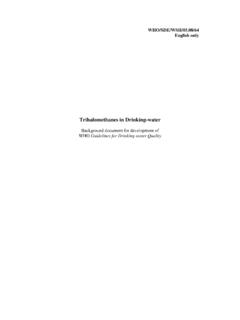Transcription of COVID-19 Treatment Guidelines (Adults)
1 COVID-19 Treatment Guidelines for severe and critical disease (hospitalised Adults) Department of Health January 2022 COVID-19 Treatment Guidelines (Adults) v1-2 Published 2/03/2022 Page 2 of 18 COVID-19 Treatment Guidelines (Adults) Published by the State of Queensland (Queensland Health), January 2022 This document is licensed under a Creative Commons Attribution Australia licence. To view a copy of this licence, visit State of Queensland (Queensland Health) 2022 You are free to copy, communicate and adapt the work, as long as you attribute the State of Queensland (Queensland Health). For more information contact: COVID-19 Therapeutics Working Group, Medication Services Queensland, Department of Health, GPO Box 48, Brisbane QLD 4001, email An electronic version of this document is available at: Disclaimer: The content presented in this publication is distributed by the Queensland Government as an information source only. The State of Queensland makes no statements, representations or warranties about the accuracy, completeness or reliability of any information contained in this publication.
2 The State of Queensland disclaims all responsibility and all liability (including without limitation for liability in negligence) for all expenses, losses, damages and costs you might incur as a result of the information being inaccurate or incomplete in any way, and for any reason reliance was placed on such information COVID-19 Treatment Guidelines (Adults) v1-2 Published 2/03/2022 Page 3 of 18 About this document This document has been developed by the Queensland Health COVID-19 Therapeutics Working Group to provide clinicians with recommendations on the Treatment options for COVID-19 in adult and adolescent patients (>16 years). For guidance in the management of children with COVID-19 , refer to the CHQ Paediatric Guideline. These Guidelines are based on the recommendations of the National COVID-19 Clinical Evidence Taskforce, the World Health Organisation (WHO) living Guidelines , and the NIH (US) and NICE (UK) Guidelines ; they will be updated frequently as new evidence is made available.
3 Table of Contents 1. Classification of severity .. 5 Mild disease .. 5 Moderate disease .. 5 Severe disease .. 5 Critical COVID-19 infection .. 5 2. Treatment .. 6 Treatment principles .. 6 Overview of COVID-19 therapy .. 7 3. Special considerations .. 8 Pregnancy .. 8 4. Detailed COVID-19 therapies .. 8 8 Remdesivir .. 9 Baricitinib .. 10 Tofacitinib .. 11 Tocilizumab .. 12 Casirivimab/imdevimab (Ronapreve ) High 13 5. Opportunistic infections .. 14 Screening .. 14 Tuberculosis .. 15 COVID-19 Treatment Guidelines (Adults) v1-2 Published 2/03/2022 Page 4 of 18 Strongyloides .. 15 Hepatitis B virus .. 15 Hepatitis C virus .. 16 6. References .. 16 7. Version control .. 17 COVID-19 Treatment Guidelines (Adults) v1-2 Published 2/03/2022 Page 5 of 18 1. Classification of severity Disease definitions according to by the Australian National COVID-19 Taskforce and World Health Organisation (WHO) living Guidelines . For patients with mild to moderate disease, see the COVID-19 Treatment Guidelines for mild-moderate disease (Adults).
4 Mild disease Patients with confirmed COVID-19 without evidence of viral pneumonia or hypoxia Moderate disease Patients with confirmed COVID-19 with signs of pneumonia including SOB, tachypnoea, or cough without features of severe pneumonia (oxygen saturation 93% and <95% on room air (RA)) Desaturation or breathlessness with mild exertion Imaging may be required to confirm the diagnosis of pneumonia Severe disease Patients with confirmed COVID-19 with signs of severe pneumonia who is deteriorating Respiratory rate (RR) 30 breaths per minute Oxygen saturation 92% RA and/or requiring oxygen supplementation Lung infiltrates 50% on imaging Critical COVID-19 infection Defined as patients with respiratory tract infections progressing to respiratory failure, septic shock, or severe organ dysfunction acute Respiratory Distress Syndrome (ARDS) o Onset usually within a week of respiratory symptoms o Bilateral opacities not explained by other aetiology o Oxygenation impairment (mild, moderate, or severe based on PaO2/FiO2) Life-threatening organ dysfunction/failure Impairment of consciousness Septic Shock COVID-19 Treatment Guidelines (Adults) v1-2 Published 2/03/2022 Page 6 of 18 o Sepsis with persistent hypotension despite volume resuscitation 2.
5 Treatment Treatment principles COVID-19 therapies other than those listed in this document should be prescribed only in the context of a clinical trial. Do not combine immunomodulator therapies. Additional dosing of tocilizumab or extended courses of baricitinib or tofacitinib are not recommended. Immunomodulator therapies should be used with caution for patients who are immunosuppressed. Current standard of care therapy for patients with severe or critical disease may include: 1. Antiviral therapy ( , remdesivir) 2. Corticosteroids (dexamethasone, prednisolone, hydrocortisone) 3. Immune modulators (tocilizumab, baricitinib, tofacitinib). Current evidence suggests that casirivimab plus imdevimab does not neutralise the omicron strain of the SARS-CoV-2 virus. It should not be used unless genotyping confirms infection with an alternate strain [1]. Medication Access and Storage: Queensland health has centralised drug purchasing and storage which is managed via interconnected I Pharmacy Service with a rapid distribution process.
6 Central pharmacy coordinates the purchasing and procurement for all COVID-19 therapy. Sites can view the stock levels at Central Pharmacy and other QH pharmacies via the live dashboard I Pharmacy State-wide - SOH and Usage - Power BI accessed with Novell user name and password. Sites are requested NOT to stockpile essential medicines and distribution will be limited to an estimated 24 hours of therapy, with allowance for distribution time across the state. COVID-19 Treatment Guidelines (Adults) v1-2 Published 2/03/2022 Page 7 of 18 Overview of COVID-19 therapy Disease Severity Therapeutic options Severe Disease (Patients with pneumonia requiring oxygen but not ventilation) Clinical signs of pneumonia (fever, cough, dyspnoea, fast breathing) plus one of the following: respiratory rate > 30 breaths/min; severe respiratory distress; or SpO2 < 93% on room air. Dexamethasone should be used in all patients requiring oxygen therapy Consider remdesivir in patients within 7 days of symptom onset for those requiring oxygen (but not ventilated) In patients with features of systemic inflammation*, consider one of: o Baricitinib (or tofacitinib if baricitinib is unavailable) o Tocilizumab (current stock levels in Australia remain low and therefore tocilizumab is not currently recommended unless the patient is pregnant) Casirivimab plus imdevimab is recommended in seronegative patients with moderate to critical COVID-19 , who are not infected with Omicron strain [1] Critical Infection (Patients requiring ventilation) Critical disease: acute respiratory distress syndrome with PaO2:FiO2 ratio of < 200 Dexamethasone should be used in all patients requiring oxygen therapy In patients with features of systemic inflammation* consider one of.
7 O Baricitinib (or tofacitinib if baricitinib is unavailable) o Tocilizumab (current stock levels in Australia remain low and therefore tocilizumab is not currently recommended unless the patient is pregnant) o Casirivimab plus imdevimab is recommended in seronegative patients with moderate to critical COVID-19 , who are not infected with omicron strain [1] *Systemic inflammation: For baricitinib systemic inflammation is considered to be present if there are elevated levels of CRP, ferritin, LDH, or D-dimer. For tocilizumab systemic inflammation is considered to be present if CRP > 75 mg/L. COVID-19 Treatment Guidelines (Adults) v1-2 Published 2/03/2022 Page 8 of 18 3. Special considerations Pregnancy Do not use baricitinib or tofacitinib in pregnant or breast-feeding women Tocilizumab may be used in pregnant women who require oxygen supplementation due to COVID-19 infection. Consider assessing initial response to corticosteroids first and use only if there are features of systemic inflammation such as CRP > 75 mg/L For pregnant women who are administered tocilizumab after 20 weeks gestation, avoid live vaccines for the newborn baby up to 6 months post-partum There is no need to avoid live vaccines in newborn babies who are breastfeeding if tocilizumab is administered post-partum Consider using remdesivir in hospitalised pregnant women with moderate or severe COVID-19 who do not require high flow oxygen or ventilation 4.
8 Detailed COVID-19 therapies Corticosteroids Multiple randomized trials indicate that systemic corticosteroid therapy improves clinical outcomes and reduces mortality in hospitalized patients with COVID-19 who require supplemental oxygen.[2, 3] This is thought to be by reducing the COVID-19 -induced systemic inflammatory response that can lead to lung injury and multisystem organ dysfunction. For patients with COVID-19 who do not require supplemental oxygen, there is evidence that it may be associated with an increased risk of progression to invasive mechanical ventilation and death. Indications Patients who require any supplemental oxygen to achieve prescribed oxygen saturation levels or patients who require supplemental oxygen but are unable to tolerate it (patients with severe or critical COVID-19 infection) Dose and duration Dexamethasone (preferred): 6 mg orally or IV daily for up to 10 days. For some critically unwell patients in ICU, dexamethasone 12 mg IV daily may be appropriate Prednisolone (alternative): 50 mg orally daily for up to 10 days COVID-19 Treatment Guidelines (Adults) v1-2 Published 2/03/2022 Page 9 of 18 Hydrocortisone (alternative): 50 mg IV 6-hourly for up to 10 days Contraindications none Additional Screen for opportunistic infections (see section 5, below) Remdesivir Remdesivir is a nucleotide prodrug of an adenosine analogue.
9 It binds to the viral RNA-dependent RNA polymerase and inhibits viral replication by terminating RNA transcription prematurely.[4, 5] Remdesivir has demonstrated in vitro activity against SARS-CoV-2. Remdesivir is currently recommended by the Australian National Taskforce, NIH (US) and NICE (UK) Guidelines . It is not recommended according to the WHO living Guidelines . This discrepancy is due to the method of analysis applied to the current evidence whereby the Australian National COVID-19 Clinical Evidence Taskforce assessed according to disease severity classification. Remdesivir is not recommended for any ventilated patients with COVID-19 infection but may be continued if already administered prior to commencing ventilation. Remdesivir is currently available through the National Medical Stockpile (NMS) and criteria for use includes the need for oxygen therapy and limits the Treatment course to 5 days for eligible patients. Indications Severe COVID-19 pneumonia in patients who require oxygen (SpO2 92% on room air) but do not require ventilation (invasive or non-invasive mechanical ventilation or ECMO) High risk for disease progression Note: In the context of its current limited availability, remdesivir should be reserved for those patients most likely to benefit.
10 Situations where patients should be prioritised include: Less than 7 days from onset of symptoms Not requiring high flow nasal oxygen Life expectancy greater than one year Contraindications eGFR < 30 mL/ ALT/AST* 5 x upper limit of normal (ULN) COVID-19 Treatment Guidelines (Adults) v1-2 Published 2/03/2022 Page 10 of 18 Dose and Duration Loading dose of 200 mg IV on day 1, then 100 mg IV daily on days 2-5 (maximum of 5 days) Discontinue if ALT/AST* > 5 ULN during Treatment , can restart when < 5 x ULN Other signs of liver inflammation (raised bilirubin, INR) eGFR < 30 mL/ *ALT/AST: hepatic enzymes alanine aminotransferase (ALT) and aspartate aminotransferase. Baricitinib Baricitinib is a Janus Kinase (JAK) inhibitor that can prevent phosphorylation of key proteins involved in the signal transduction that leads to immune activation and inflammation ( , the cellular response to proinflammatory cytokines such as interleukin [IL]-6).[6, 7] Baricitinib may also have antiviral activity by interfering with the SARS-CoV-2 virus entering and infecting potentially susceptible cells.










